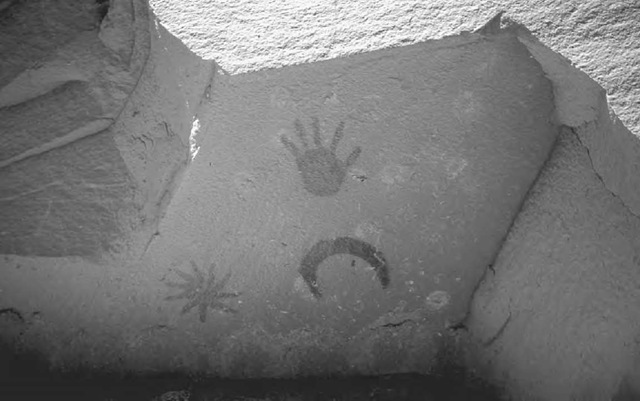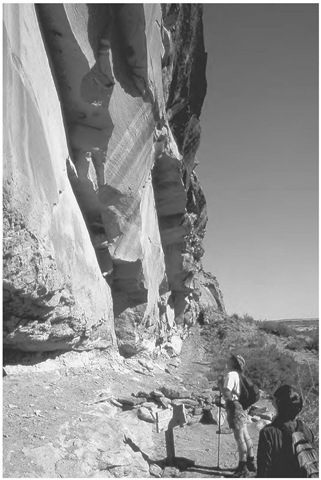The walker exploring the trail northwestward up Chaco Canyon toward the ruins of Penasco Blanco—one of several Great Houses built in the canyon by Anasazi peoples in the tenth and eleventh centuries—passes a number of notable rock-art panels, but one in particular is remarkable in its simplicity and power. At one point, high up the vertical sandstone cliff that forms the side of the canyon, some 6 meters (20 feet) off the ground, is a narrow overhang. And painted on the bottom of this are three straightforward designs: a (life-sized) hand, a ten-pointed star, and a crescent—surely a depiction of the crescent moon.
This site has achieved particular notoriety because it has been claimed to be a representation of a supernova—an exploding star, previously invisible to the naked eye, that suddenly grows spectacularly in brightness. The supernova in question is one that astronomers know to have occurred in c.e. 1054 and which was certainly recorded by the ancient Chinese. It is often referred to nowadays as the Crab supernova, because the aftermath of the explosion is visible to astronomers today as a cloud of gas in the constellation of Taurus known as the Crab Nebula. For a few weeks the new star was significantly brighter even than the planet Venus and visible in broad daylight.
Anyone who has seen Venus and the crescent moon close together, hanging low in a clear blue and otherwise empty twilight sky, will know just what a conspicuous sight this is. In 1054, though—in the early morning of July 5 (in today’s Gregorian calendar)—an even more extraordinary sight would have greeted anyone sheltering by the cliff looking eastwards into the predawn sky. On this morning, the crescent moon would have appeared right next to the supernova, and the suggestion is that this is precisely what the Chaco pictograph represents. (It is a pictograph rather than a petroglyph because it is painted onto, rather than carved out of, the rock.)
A number of factors seem to support this argument. First, the date fits with the archaeological evidence of when Anasazi activity reached such extraordinary heights in this apparently inhospitable valley, with the construction of numerous Great Houses and kivas. Second, the juxtaposition of the crescent moon and star in the pictograph fits the actual configuration visible in the sky on that July morning in 1054. Third, several other rock-art sites in the western United States have been interpreted as depictions of the same event. And finally, there is independent evidence of the ancient Chacoans’ interest in astronomy, manifested most famously in the interplay of sunlight and shadow on the “sun dagger” petroglyph on Fajada Butte at the eastern entrance to the canyon.
The situation of the “supernova” petroglyph on the bottom of a rock overhang.
Nonetheless, even if we accept that the crescent is an unmistakable representation of the crescent moon, is the star necessarily the Crab supernova? The answer, of course, is no. The “star and crescent” is one of the most pervasive astronomical symbols among humankind, particularly in the Islamic world. It is usually taken to represent the crescent moon and Venus, which— aside from transient phenomena such as supernovae—is the brightest object in the sky apart from the sun and moon. Eye-catching conjunctions of the crescent moon and Venus occur at quite frequent intervals (several times during each eight-year period that it takes Venus to return to essentially the same place relative to the sun and stars). Could the juxtaposed star and crescent symbols in the Chaco pictograph simply be depicting one of these conjunctions of the crescent moon and Venus? They clearly could: just because one rather attractive and exciting interpretation seems to fit the evidence, we cannot accept this as incontrovertible proof if there remains at least one equally plausible, though slightly more mundane, alternative.
Another uncomfortable question is: what is the hand doing there? It has been argued that it is merely a symbol showing that the place is sacred, but its presence might also suggest the uncomfortable possibility that these three icons belonged together as a triplet, conveying symbolic meanings perhaps, rather than (two of them but not the other) representing something “literal” in the sky.
What characterizes all these arguments is that they are based on speculations that pay no attention to the cultural context. In fact, all of them are rendered futile by an observation made by a Zuni ethnographer almost as soon as the supernova interpretation was originally proposed, back in 1975. The modern Zuni have sun-watching stations for calendrical observations, and traditionally mark them using a pictograph with four elements: a crescent, a hand, a star, and a sundisk. Although more worn and less visible, there is indeed a sundisk accompanying the other symbols on the overhang. This, surely, was a sun-watching station: astronomical certainly, but with nothing at all to do with the Crab supernova.


